Text
Daily Cuteness: Airedale Terrier











7 notes
·
View notes
Text
HOW TO HELP YOUR DOG DEAL WITH SEASONAL ALLERGIES

For some people, seasonal allergies are a real pain. Whether you’re bothered by a runny nose, itchy eyes, or endless sneezing, it can be a tough time of year to endure.
Just like their human parents, some dogs suffer from the aggravating effects of seasonal allergies as well. Besides chemicals such as those found in household cleaning products, cigarette smoke and certain perfumes, dogs can also be allergic to natural, seasonal substances. This can include plant and tree pollens, mold spores, dust, feathers and fleas.
A dog’s allergy symptoms are generally similar to those experienced by humans: the immune system overreacts to one or more offending substances, leading to itchiness and irritation. Your dog may lick or scratch themselves, develop irritated eyes, or sneeze repeatedly. Some dogs experience itchy, swollen skin, while others suffer from diarrhea and vomiting. In certain cases, a secondary infection may develop.
Here are a few things you should do to help control any discomfort your dog may be dealing with due to seasonal allergies and reduce the risk of more serious problems.

ADAPT YOUR DAILY WALK ROUTINE
If possible, avoid walking your dog in the early morning or late afternoon, when pollen levels are typically highest. Steer clear of fields and parks where offending plants are common.
When you return home, wipe your dog’s body and paws with a moist cloth or a hypoallergenic, fragrance-free grooming wipe from your local pet store. This will remove excess pollen and other allergens from your dog’s fur and skin without the hassle of a full bath. Pay special attention to the paws, as the sensitive skin here is often affected by allergens.
Some pet parents soak their dog’s paws in apple cider vinegar to remove pollen and other substances. If using this method, mix 2 parts water with 1 part apple cider vinegar. Another solution is to put boots on your dog’s paws to prevent them from stepping in irritants and then tracking them into your house.

CLEAR THE AIR… AND OTHER SURFACES
Inside your home, regularly change air filters to cut down on airborne allergens that enter through open doors and windows. Running an air conditioner or a dehumidifier will help remove moisture from interior air, making it harder for mold to grow in your home. Minimize the amount of time your dog spends in damp environments, such as basements, bathrooms, or laundry rooms, as these places are more susceptible to mold growth. Vacuum at least once a week, and remember to clean curtains and rugs that may have picked up dust and pollen.
Protect your dog from backyard dangers. Many popular veggies like onions, garlic, tomatoes, and chives are poisonous to dogs and should be fenced off to prevent your furry friend from getting into them.

DON’T SLEEP ON IT
It's important to keep the surfaces your dog sleeps on clean, as they can quickly become covered in allergens. To achieve this, wash them in hot water every week. To make the task easier, consider putting towels or blankets on top of beds and chairs, and make sure to keep any offending substances away from the surface underneath. Also, don't forget to wash any soft toys your dog plays with regularly.

JUMP IN THE BATH
To prevent dry and itchy skin in dogs, it is recommended to bathe them more often with the advice of a veterinarian. While washing their fur, use a gentle, hypoallergenic anti-itch shampoo that contains a soothing ingredient like oatmeal, aloe, or evening primrose oil. Some dog owners prefer to give their pets a 10-minute soak in a bath mixed with a gentle moisturizing oil.

SUPPLEMENT YOUR DOG’S DIET
Consider giving your furry friend a natural dietary supplement like fish oil or a fatty acid such as omega-3 or omega-6 oil to alleviate itchiness and promote healthy skin. Coconut oil has also been shown to be effective in suppressing allergic reactions and improving skin health. To ensure your dog's overall well-being, it is essential to keep their drinking water and bowl clean and free of any contaminants.

FURTHER TREATMENTS
If your dog is constantly licking, scratching, or chewing, and has red, irritated skin or hair loss, it's best to schedule an appointment with your veterinarian. Depending on the severity of the problem, a professional can provide more aggressive treatments such as antihistamines, steroids, or allergy shots, which are also known as immunotherapy.
3 notes
·
View notes
Text
Daily Cuteness: Dogs With Blue Eyes
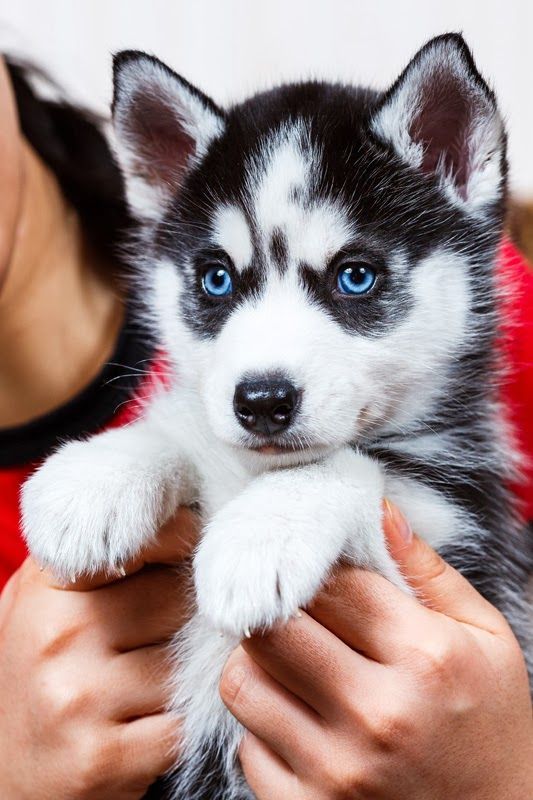






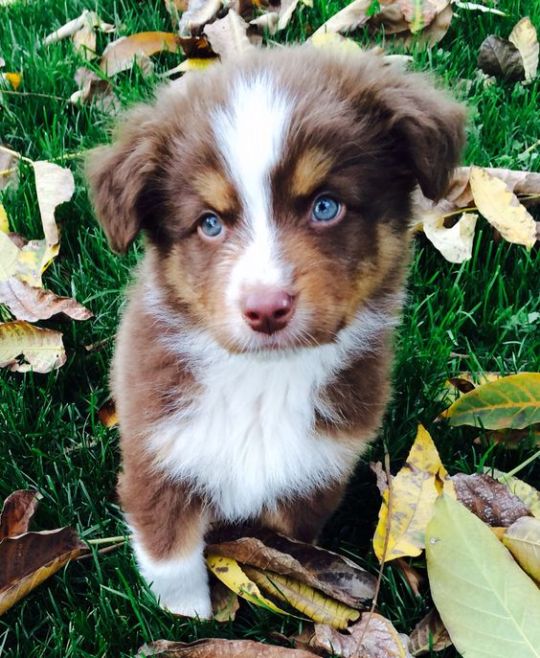
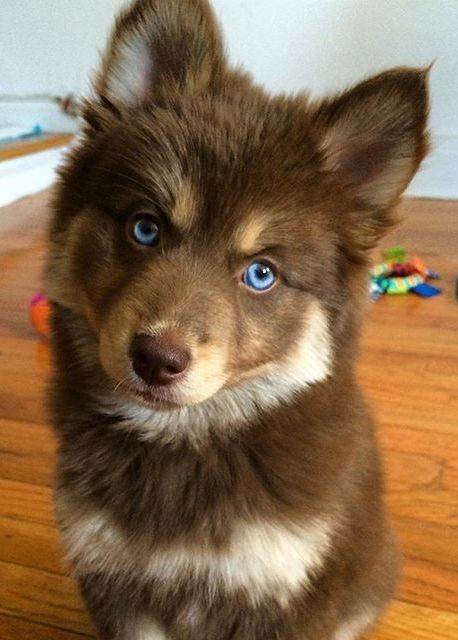
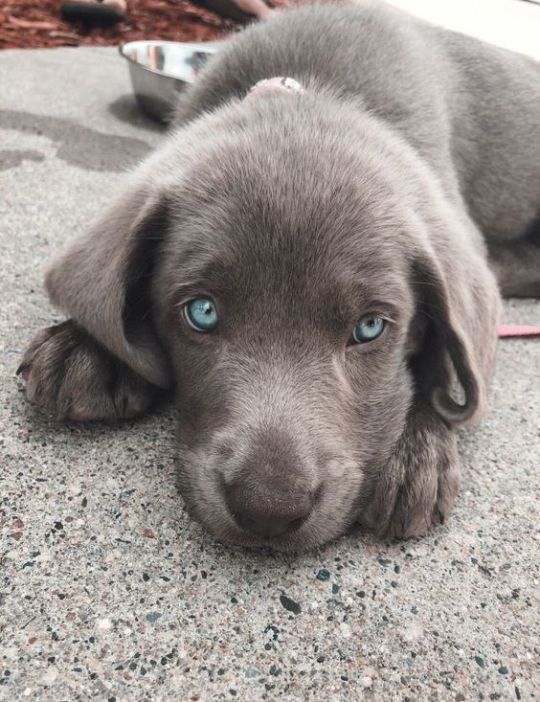

#dogs with blue eyes#blue eyed dogs#blue eyed puppies#blue eyes dogs#cute dogs#funny dogs#cute puppies#cute puppy#daily cuteness
10 notes
·
View notes
Text
Daily Cuteness: Spring Vibes Dogs










#daily cuteness#cute dogs#spring vibes#spring dogs#dog vibes#happy dogs#funny dogs#cute puppy#cute puppies
11 notes
·
View notes
Text
Daily Cuteness: Chocolate Labrador Retriever
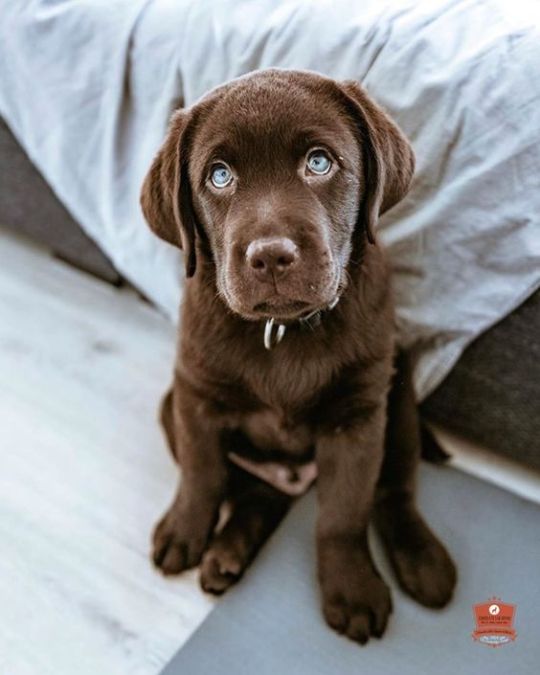

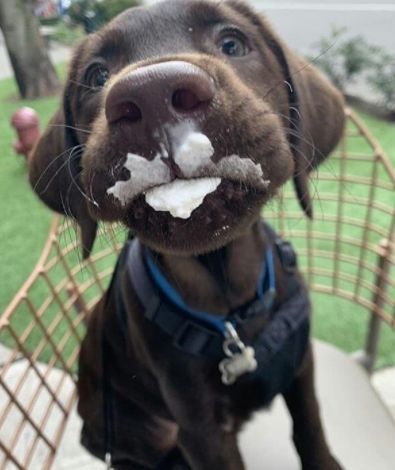





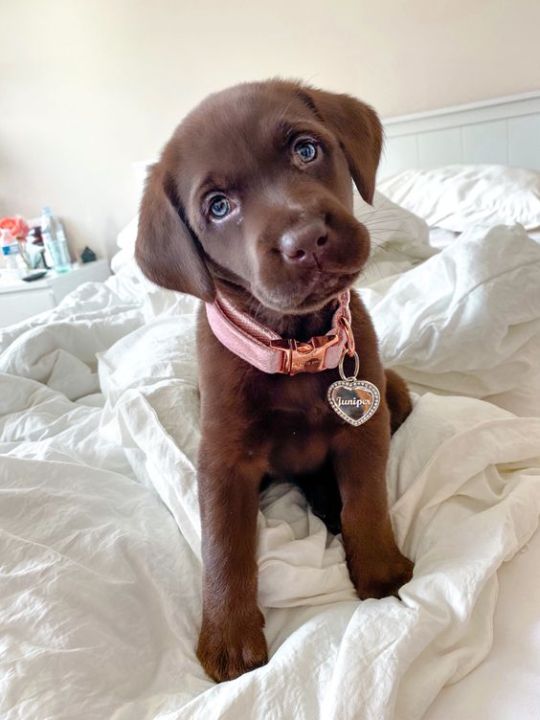



#chocolate labrador retriever#chocolate lab#cute dog#funny dog#funny puppy#cute puppy#brown lab#brown labrador retriever#daily cuteness
8 notes
·
View notes
Text
Best Leashes For Large Dogs

The best leashes for big dogs are sturdy and comfortable. They can be made from durable materials like nylon, rope, or leather. Some leashes also have reflective materials, a bungee, and 360-degree clips.

Leather Leash For Large Dogs
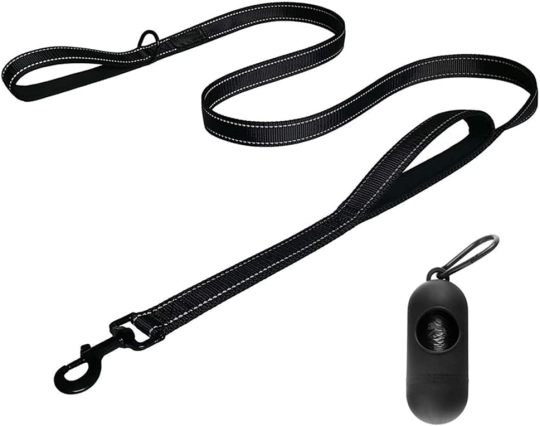
Double Handle Reflective Large Dog Leash

Heavy Duty Rope Bungee Large Dog Leash
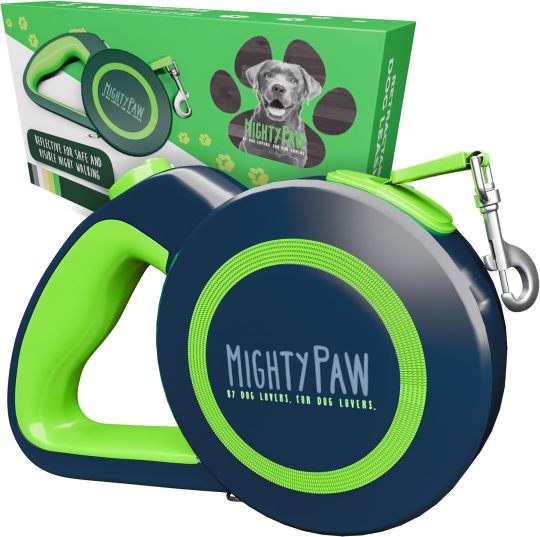
Retractable Dog Leash

Padded Handle Large Dog Leash
1 note
·
View note
Text
Daily Cuteness: Pomsky

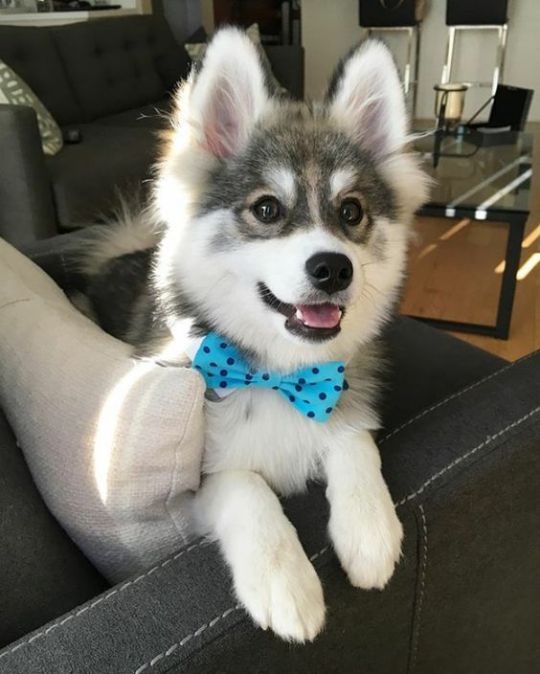



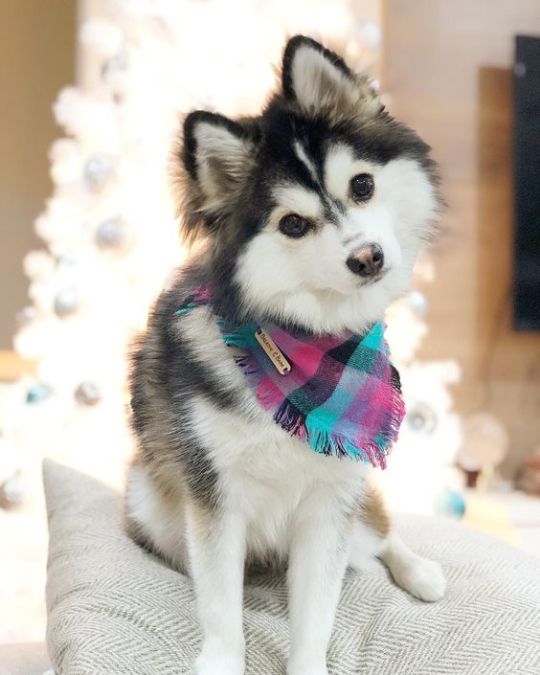
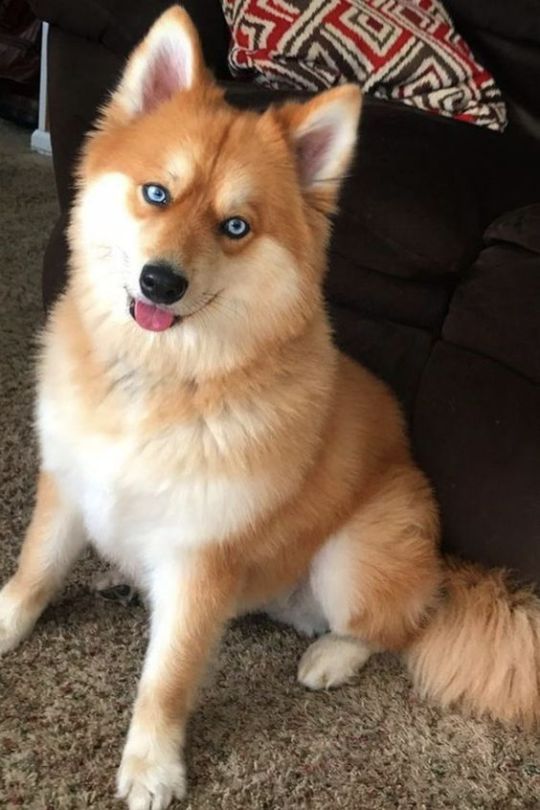


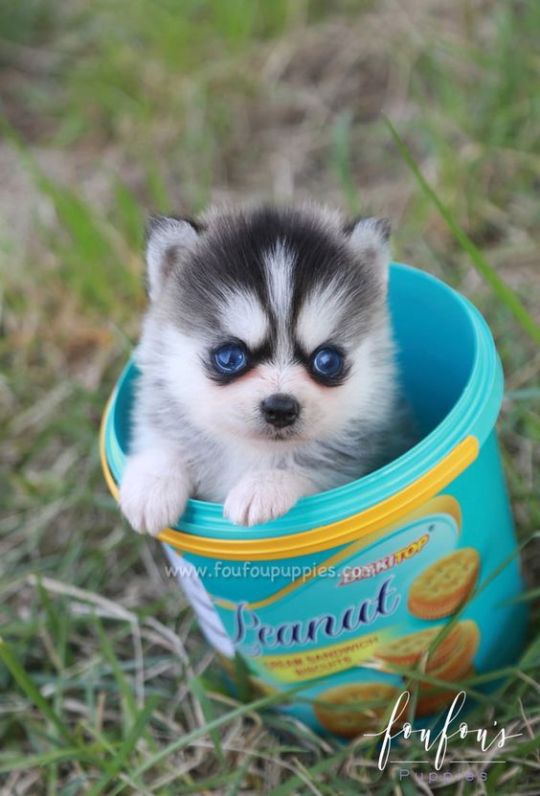


23 notes
·
View notes
Text
Easy Homemade Dog Treats!

All it takes is banana, peanut butter, and oats and you can make these cute cookies for your pup, or for a doggy friend of yours. Not only are these easy to make, but they are so much more affordable than store-bought treats and dogs LOVE them!


Easy Homemade Dog Treats!
Servings: 40 (Makes about 40 treats depending on the cookie cutter size)
Ingredients
2 cups oats (old fashioned, 1-minute oats, or instant) plus more if needed- see step 3
2 medium ripe bananas
½ cup natural peanut butter
Instructions
Preheat your oven to 300F (150C). Line a baking sheet with parchment paper.
Add the oats to a food processor and grind until they reach a fine powder. (If you do not have a food processor, see the recipe notes for other options). Add the bananas and peanut butter and blend until a sticky dough is formed.
Remove from the food processor and roll out on a lightly floured surface. (Use whole wheat flour, more ground oats, or another dog-safe flour that you have on hand). I used a heart cookie cutter to cut out the treats but you could use any cookie cutter, or just cut them into squares with a knife or pizza cutter.
Lay the treats on the prepared baking sheet and bake for 25 to 30 minutes, until the treats are puffed up a bit, dry and dark brown on the bottoms, (they will still feel soft when first removed from the oven). The treats will get a bit more firm once they are cool but will still be a slightly softer dog treat. Let cool before giving one to your pup.
Store in an air-tight container at room temperature for up to 1 week, in the fridge for up to 2 weeks, or I like to store them in my freezer which makes them firmer and makes them stay fresh a long time.
Notes
If you do not have a food processor, you can still make these treats. Grind the oats up in a blender or coffee grinder, then add the ground oats to a bowl with the peanut butter and mashed banana and mix to make a dough. Or you could buy oat flour and use that instead. You will need less oat flour as it is denser, so start with 1 cup and add more as needed.
#healthy dog treats#dog peanut butter treats#dog treat recipes#dog snack recipes#homemade dog treats#homemade dog snacks
14 notes
·
View notes
Text
Daily Cuteness: Shar Pei







#sharpei#shar pei#daily cuteness#Chinese shar pei#wrinkly dog#funny dog breeds#cute dogs#funny dogs#cute puppy#cute puppies#funny puppies
3 notes
·
View notes
Text
How to Stop a Dog From Barking When They’re Home Alone

It’s a common problem, but an annoying one: Your dog is well-behaved when you’re home. But as soon as you leave, they can’t stop making noise. Your dog has their reasons for acting out. Boredom, restlessness, fear, and separation anxiety are all common reasons that your dog might bark and whine while you’re gone. Wondering how to stop a dog from barking when they’re home alone? Try these tricks to distract or redirect their behavior from barking.
Make Sure They Get Exercise
Make sure you give your dogs enough exercise before you leave in the morning. Tired dogs are more likely to want a quiet rest time. If possible, have a dog walker come during the middle of the day to provide more exercise.
Try Toys and Canine Puzzles
There are a number of commercial and homemade products that give your dog something to do while you’re gone. You can stuff a hollow toy with a spreadable treat, like dog-safe peanut butter, and the dog will work to get the snack out. You can also hide dog treats in an interactive dog puzzle. Your dog may be too busy to bark, since they’ll be looking for their treats.

Turn on Familiar Sounds
For dogs who bark when owners are gone, trainers often suggest leaving the dog with some familiar sounds such as a radio or television. The idea is that these sounds resemble the household noises when the owner is present, which may reassure your dog.
Citronella Collars
Citronella collars spray a burst of citronella when the dog barks. Citronella is made from the oils of lemongrass, and it is often used in perfumes, candles, and incense. This collar is seen as a humane alternative to shock bark collars.
Anti-Barking Devices (Non-Collar)
There are several anti-barking devices that do not involve collars. These devices detect barks and sends a high-pitched sound that only dogs can hear.
What to Do if Barking Continues
If you try these solutions and your dog’s barking continues, you might need to play detective and explore beyond the simplest solutions. Keep in mind that as the dog’s trainer (or animal behaviorist), finding the function of the behavior is important. Once you identify what triggers their barking, you can go about reducing or eliminating that trigger.
If you’re not able to stop a dog from barking, you also may want to take your dog to the vet. They will be able to identify (or rule out) any underlying health issues.
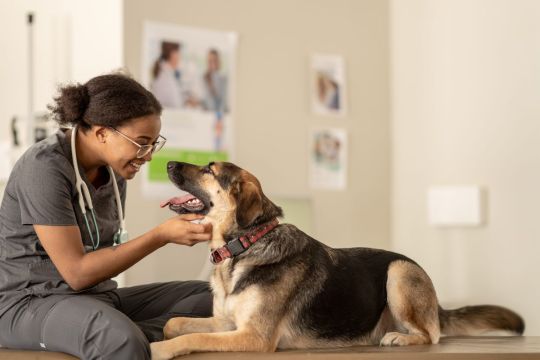
What About Separation Anxiety?
A study on dog separation anxiety confirmed that this a complex problem. Remember that anxiety is a term that means your dog is sufficiently stressed that there will be some physiological signs that will be manifested by behaviors such as pacing, whining, panting or drooling.
Your smartphone can be a very useful tool for diagnosing the root of your dog’s behavior. Consider using a smartphone app like Barkio or Pet Monitor VIGI to observe your dog remotely, or a simple dog camera or monitor. By watching your dog’s behavior from afar, you’ll be able to see any signs of anxiety in your absence. You can also see if they bark when squirrels are in the yard, or if your dog gets destructive when they’re simply bored.
Separation anxiety can be a tough problem to treat — but these best practices can help you make inroads on the problem. Some of them are similar to the more general fixes for barking:
Exercise your dog vigorously before you leave. This allows your dog to rest well in your absence.
Leave “activities” to keep your dog occupied. Examples include a safe chew toy, or an interactive game where your dog works to get a treat out of a puzzle.
Provide training while you’re home. Leave the dog for a few seconds, come back into the house, and reward them for quiet, calm behavior. Add a few seconds at a time. Although this process does work, it requires a lot of patience. It’s a good idea to avoid adding too much time at once, since that won’t work.
Depending on the severity of your dog’s anxiety problem, you may want to talk to your dog’s veterinarian. They may prescribe anti-anxiety medications for your dog that you’ll eventually phase out.
Recruiting a professional dog trainer can also help. Training an anxious dog isn’t always easy, and your dog is very clued in to your mood. Involving a professional makes it easier for you to stay calm and relaxed, which in turn helps your dog stay calm too.
#barking dog#dog home alone#dog behavior#how to stop barking#excessive barking#separation anxiety in dogs#dog training#how to dog
3 notes
·
View notes
Text
Daily Cuteness: Finnish Spitz


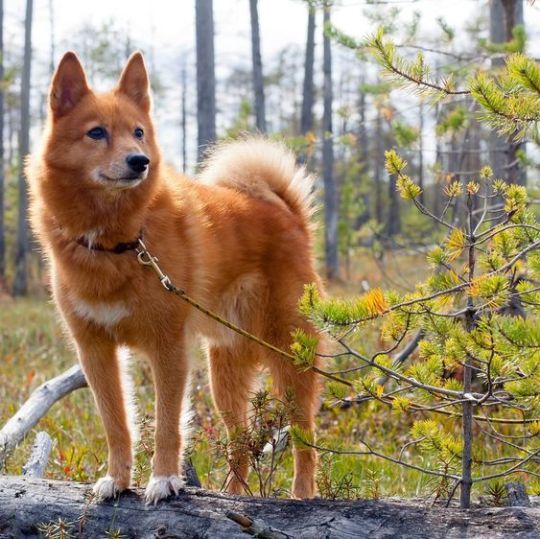

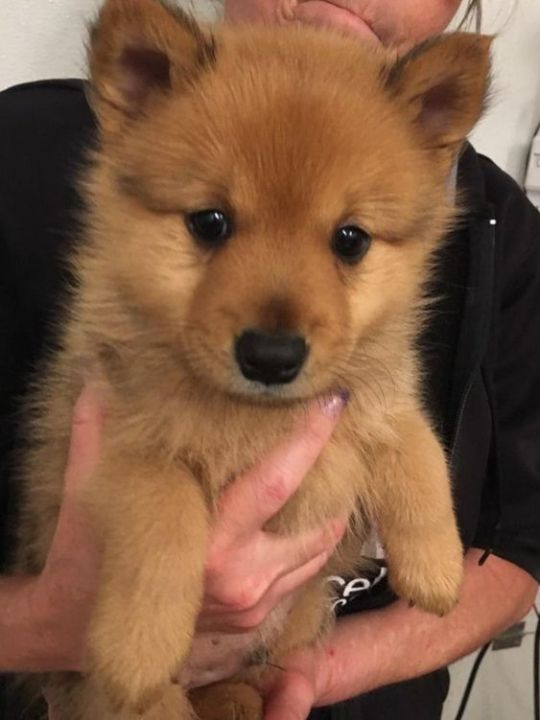
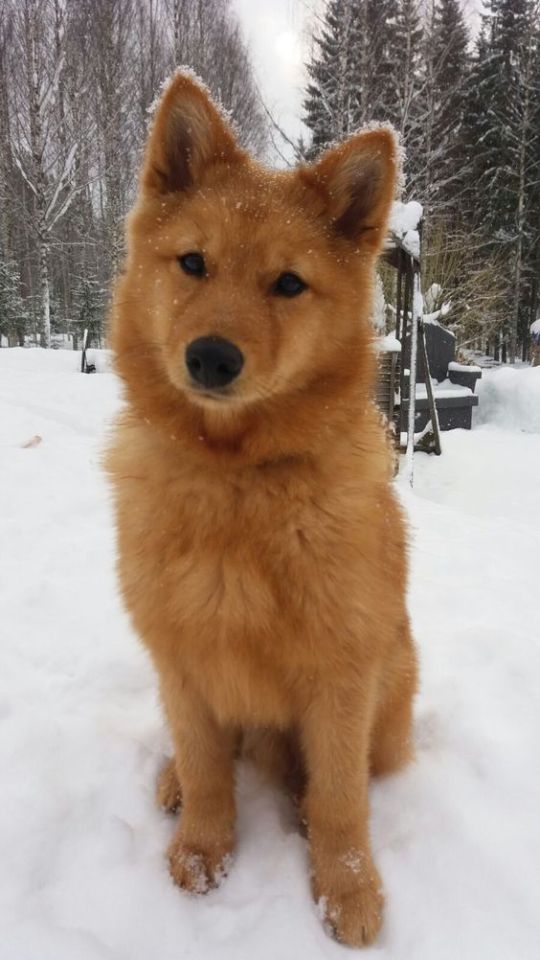




102 notes
·
View notes
Text
First-Year Puppy Vaccinations

When you bring that fuzzy ball of puppy energy into your home, you know right away that your new puppy depends on you for, well, everything. It’s up to you to give your new puppy all the care they need every day. It can be a little intimidating — your puppy needs the best puppy food, plenty of attention, puppy training, puppy-safe toys, puppy socialization, a comfortable place to sleep, and proper veterinary care. And that includes making sure to schedule puppy shots throughout your puppy’s first year.
Which Shots Do Puppies Need?
Going to the vet over several months for a series of puppy vaccinations—and then for boosters or titers throughout your dog’s life—may seem inconvenient, but the diseases that vaccinations will shield our puppies and dogs from are dangerous, potentially deadly, and, thankfully, mostly preventable.
We read about so many different dog vaccinations, for so many different illnesses, that it can sometimes be confusing to know which vaccinations puppies need and which puppy shots are important but optional. Here is an overview of the diseases that puppy vaccinations will help your pet avoid.
Bordetella Bronchiseptica
This highly infectious bacterium causes severe fits of coughing, whooping, vomiting, and, in rare cases, seizures and death. It is the primary cause of kennel cough. There are injectable and nasal spray vaccines available.
If you plan on boarding your puppy in the future, attending group training classes, or using dog daycare services, often proof of this vaccination will usually be required.
Canine Distemper
A severe and contagious disease caused by a virus that attacks the respiratory, gastrointestinal (GI), and nervous systems of dogs, raccoons, skunks, and other animals, distemper spreads through airborne exposure (through sneezing or coughing) from an infected animal. The virus can also be transmitted by shared food and water bowls and equipment. It causes discharges from the eyes and nose, fever, coughing, vomiting, diarrhea, seizures, twitching, paralysis, and, often, death. This disease used to be known as “hard pad” because it causes the footpad to thicken and harden.
There is no cure for distemper. Treatment consists of supportive care and efforts to prevent secondary infections, control symptoms of vomiting, seizures and more. If the animal survives the symptoms, it is hoped that the dog’s immune system will have a chance to fight it off. Infected dogs can shed the virus for months.
Canine Hepatitis
Infectious canine hepatitis is a highly contagious viral infection that affects the liver, kidneys, spleen, lungs, and the eyes of the affected dog. This disease of the liver is caused by a virus that is unrelated to the human form of hepatitis. Symptoms range from a slight fever and congestion of the mucous membranes to vomiting, jaundice, stomach enlargement, and pain around the liver. Many dogs can overcome the mild form of the disease, but the severe form can kill. There is no cure, but doctors can treat the symptoms.
Canine Parainfluenza
This is one of several viruses that can contribute to kennel cough.
Coronavirus
The canine coronavirus is not the same virus that causes COVID-19 in people. COVID-19 is not thought to be a health threat to dogs, and there is no evidence it makes dogs sick. Canine coronavirus usually affects dogs’ gastrointestinal systems, though it can also cause respiratory infections. Signs include most GI symptoms, including loss of appetite, vomiting, and diarrhea. Doctors can keep a dog hydrated, warm, and comfortable, and help alleviate nausea, but no drug kills coronaviruses.
Heartworm
When your puppy is around 12-to-16 weeks, talk to your vet about starting a heartworm preventive medication. Though there is no vaccine for heartworm in dogs, it is preventable with regularly administered heartworm medication that your veterinarian will prescribe.
The name is descriptive — these worms lodge in the right side of the heart and the pulmonary arteries (that send blood to the lungs), though they can travel through the rest of the body and sometimes invade the liver and kidneys. The worms can grow to 14 inches long and, if clumped together, block and injure organs.
A new heartworm infection often causes no symptoms, though dogs in later stages of the disease may cough, become lethargic, lose their appetite or have difficulty breathing. Infected dogs may tire after mild exercise. Unlike most of the conditions listed here, which are passed by urine, feces, and other body fluids, heartworms are transmitted by mosquitoes. Therefore, diagnosis is made via a blood test and not a fecal exam.
Kennel Cough
Also known as infectious tracheobronchitis, kennel cough results from inflammation of the upper airways. It can be caused by bacterial, viral, or other infections, such as Bordetella and canine parainfluenza, and often involves multiple infections simultaneously. Usually, the disease is mild, causing bouts of harsh, dry coughing; sometimes it’s severe enough to spur retching and gagging, along with a loss of appetite. In rare cases, it can be deadly. It is easily spread between dogs kept close together, which is why it passes quickly through kennels. Antibiotics are usually not necessary, except in severe, chronic cases. Your vet may prescribe a dog-safe cough suppressant to help your dog (and you) get some rest, and some dog-safe throat soothers can help make a dog more comfortable.
Leptospirosis
Unlike most diseases on this list, Leptospirosis is caused by bacteria, and some dogs may show no symptoms at all. Leptospirosis can be found worldwide in soil and water. It is a zoonotic disease, meaning that it can be spread from animals to people. When symptoms do appear, they can include fever, vomiting, abdominal pain, diarrhea, loss of appetite, severe weakness and lethargy, stiffness, jaundice, muscle pain, infertility, kidney failure (with or without liver failure). Antibiotics are effective, and the sooner they are given, the better.
Lyme Disease
Unlike the famous “bull’s-eye” rash that people exposed to Lyme disease often spot, no such telltale symptom occurs in dogs. Lyme disease (or borreliosis) is an infectious, tick-borne disease caused by a type of bacteria called a spirochete. Transmitted via ticks, an infected dog often starts limping, his lymph nodes swell, his temperature rises, and he stops eating. The disease can affect his heart, kidney, and joints, among other things, or lead to neurological disorders if left untreated. If diagnosed quickly, a course of antibiotics is extremely helpful, though relapses can occur months or even years later.
Talk to your vet about when your puppy will be old enough for tick preventatives. Once your puppy is old enough, keep your dog on tick preventative medication, topicals, or wearables to help stop ticks from biting in the first place.
Parvovirus
Parvo is a highly contagious virus that affects all dogs, but unvaccinated dogs and puppies less than four months of age are at the most risk to contract it. The virus attacks the gastrointestinal system and creates a loss of appetite, vomiting, fever, and often severe, bloody diarrhea. Extreme dehydration can come on rapidly and kill a dog within 48-to-72 hours, so prompt veterinary attention is crucial. There is no cure, so keeping the dog hydrated and controlling the secondary symptoms can keep him going until his immune system beats the illness.
Rabies
Rabies is a viral disease of mammals that invades the central nervous system, causing headache, anxiety, hallucinations, excessive drooling, fear of water, paralysis, and death. It is most often transmitted through the bite of a rabid animal. Treatment within hours of infection is essential, otherwise, death is highly likely. Most states require regular rabies vaccinations. Check with your vet about rabies vaccination laws and requirements in your area.
Talk with your veterinarian about more information and guidance on necessary and optional vaccinations.
Puppy Vaccination Schedule
The first thing to know is that there is not just one puppy vaccination schedule for all dogs. Factors such as which part of the country you live in, and your dog’s individual risk factors will come into play. Some dogs do not need every vaccine. This decision is between you and your veterinarian. Always discuss puppy vaccinations at your regularly scheduled appointments.
That said, here is a generally accepted guideline of the puppy vaccination schedule for the first year.
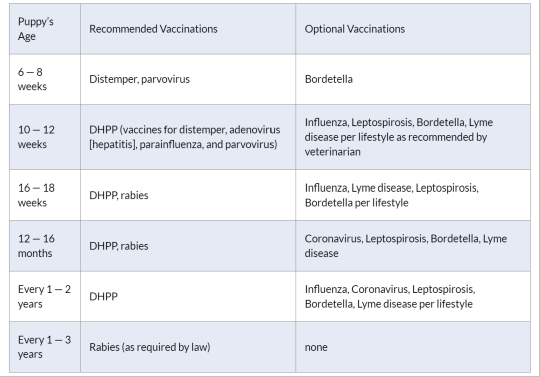
How Much Do Puppy Vaccinations Cost?
How much puppy vaccinations will cost depends on several factors. Where you live is a big one: Veterinarians in crowded and expensive urban areas will generally charge more than a rural vet in a small town. You may be able to find low-cost clinics providing rabies vaccinations sponsored by your local municipal government. But no matter what the range in costs, some vaccines, such as the “core vaccines” and rabies, are necessary.
The average cost can average around $75—100. These will include the core vaccines, which are administered in a series of three: at 6-, 12-, and 16 weeks old.
The core vaccines include the DHLPP (distemper, hepatitis, leptospirosis, parvo, and parainfluenza). Your pup will also need a rabies vaccination, which is usually around $15—20. (Some clinics include the cost of the rabies vaccination.)
Often animal shelters charge less for vaccines — approximately $20 — or are even free. If you acquired your dog from a shelter, he would most likely have been vaccinated, up until the age when you got him.
The initial puppy vaccination costs during the first year are higher than during adulthood.
Vaccinations for Adult Dogs: Boosters and Titers
There is a difference of opinion about having your adult dog vaccinated every year. Some vets believe too many vaccinations in adult dogs pose health risks. But others disagree, saying that yearly vaccinations will prevent dangerous diseases such as distemper. Talk with your vet to determine what kind of vaccination protocol works for you and your dog.
Many dog owners opt for titer tests before they administer annual vaccinations. Titer tests measure a dog’s immunity levels, and this can determine which, if any, vaccinations are necessary. One key exception to this is rabies: a titer test is not an option when it comes to the rabies vaccine. This vaccination is required by law across the United States. Your vet can tell you the schedule for your particular state, with boosters often lasting three years.
And it’s all worth it. For your effort and care your puppy will lavish you with lifelong love in return. This critical first year of her life is a fun and exciting time for both of you. As she grows physically, the wonderful bond between you will grow, too.
#puppy vacinations#puppy vaccines#puppy shots#puppy shots schedule#dog vaccinations#dog health#puppy health
4 notes
·
View notes
Text
Daily Cuteness: Boston Terrier



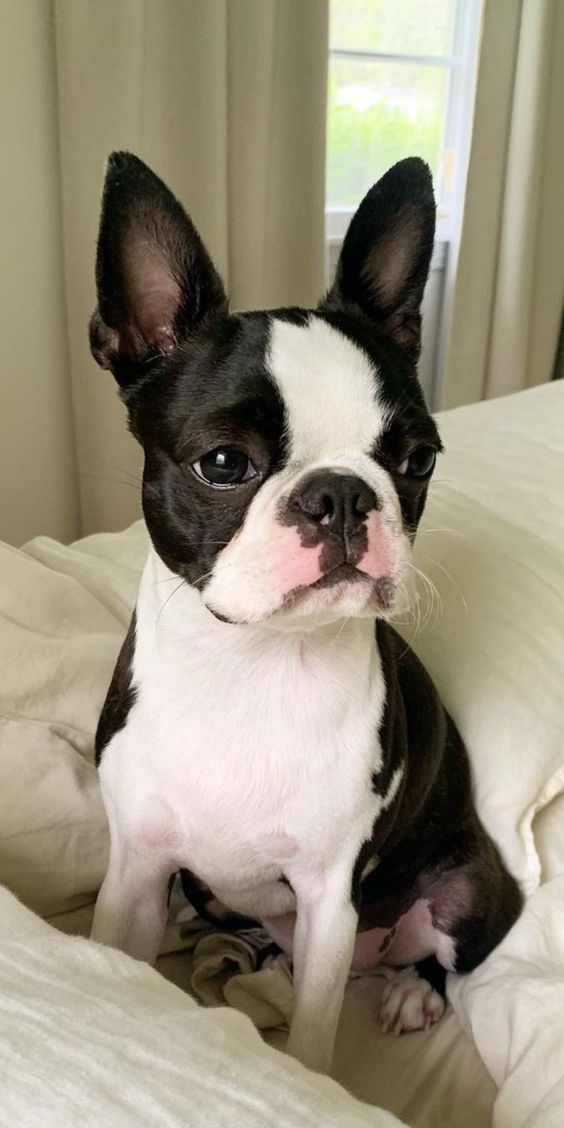











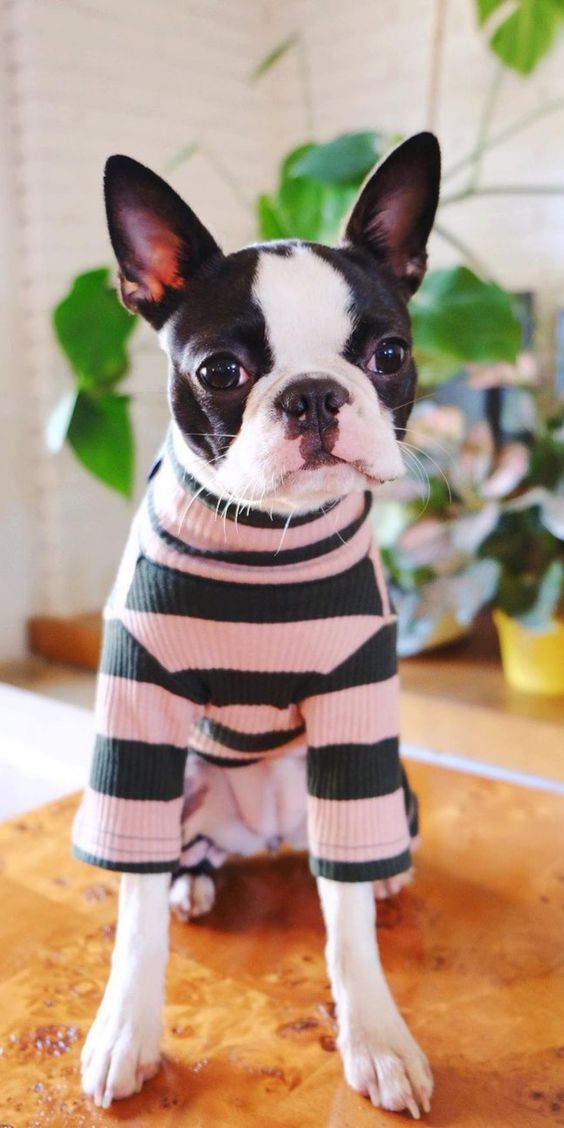
6 notes
·
View notes
Text
Dangers of Road Salts to Pets

In the winter, our dogs still need to get outside to use the bathroom and for occasional exercise. If you live in an area that gets a lot of snow, however, it’s important to understand the dangers of rock salt and de-icers.
Why Avoid De-icers?
Road salt and de-icers are known irritants for your pet’s feet. This is because most road salt is made from chlorine and sodium calcium, magnesium or potassium. Unlike regular table salt, road salt contains heavy metals and other contaminants that can be harmful to our pets. These chemicals can cause painful burning and cracked feet that dry out the pads and cause serious irritation.
Protecting Your Dogs’ Feet
Chances are if you have pets, you already use safe de-icers at home, but if you take your pet anywhere, you must be concerned about what he will encounter on someone else’s property. To protect your dog’s feet, avoid walking in places where salt is used. Instead of taking a stroll along the road, keep your pup on the grass. Also, be sure to wash your dog’s paws in warm water after a walk just in case they’ve encountered salt. Use a dry towel to pat dry.
Paw booties are also another alternative to keep your pet’s feet dry and comfortable. They come in a wide variety of sizes and styles to suit your pet. You can also apply a product like a paw salve or Musher’s Secret, which creates a barrier to prevent exposure to harmful chemicals.
4 notes
·
View notes
Text
Daily Cuteness: Maltipoo









13 notes
·
View notes

